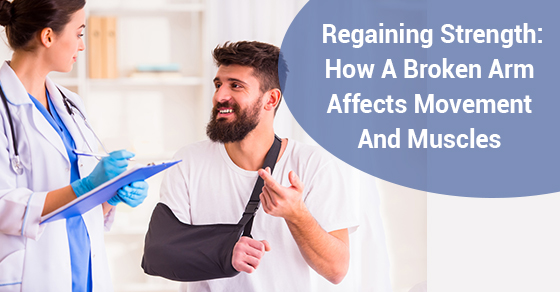A broken arm can sideline you for months, especially if the break affects your dominant hand. The movement and muscle groups in your arm take a backseat when you suffer an injury like a fracture. This is because the muscles and bones in our body are codependent and rely on each other to fully function. You will need to regain your arm strength through physiotherapy (depending on the severity of your injury) in order for movement to be restored.
What muscles are found in the arm?
From the top of our arms to our fingertips, we have 30 bones. Each bone is supported by a distinct muscle group. The most important groups are the biceps, triceps and forearms because these are the muscles we use the most. Our arm bones are supported by ligaments and joint capsules that allow the muscles to have a full range of motion. The larger muscles help to flex and extend the arms, while the smaller muscles control our fine motor skills. If you break your arm, the muscles suffer as well.
What are the main arm functions our muscles perform?
The muscles in arms are what control the positioning and movement of our elbow joint, wrist and hands. Without these muscles we would not be able to perform everyday activities like writing, typing, pointing and grabbing. Moreover, our capacity to lift things comes from our arm muscles. When we break an arm, the muscles that allow for movement shut down.
What happens when you break your arm?
If you fracture your humerus, the upper arm bone that extends from shoulder to elbow, it means there was a direct blow to the area. Usually, humerus fractures occur after a high-impact fall or car accident. If you fracture your radius and ulna, the forearm bones that extend from elbow to wrist, that means there was a direct impact to that area from falling on an outstretched arm or pressure from a motor vehicle collision.
Humerus fractures generally do not involve surgery and the arm is left to heal in a cast, splint or functional brace. If the fracture to the humerus is severe, it will require a surgical procedure that repairs the bone with plates, screws or a metal rod. Once the healing process begins, you will meet with a physiotherapist who will help restore the function of your arm and strengthen the muscles. Range of motion will also be repaired through physiotherapy, and any muscle groups that were inactive while you had your cast on will be retrained.
Forearm fractures are treated with surgery if they are severe. If not, they are left to heal in a cast, brace or splint. Because forearm motion is so particular, you will need physical therapy to help get your arm back in working order. As with upper arm fractures, a physiotherapist will help restore the function of your arm along with strengthening and retraining the surrounding muscle groups.
What are the symptoms of a broken arm and how are the muscles affected?
When you fracture your arm, you will feel pain. Eventually the pain will subside and transition into swelling, tenderness and bruising. You will have limited motion in your arm and may have numbness in your hand or wrist. Your muscles will become immobilized because the symptoms of a broken arm will not allow you to use them without pain. When muscles immobilize, they wither and weaken. If you do not undergo physical therapy as part of your broken limb treatment, you could lose proper function in your arm and have trouble moving it at all in the future.
How long does the therapy process take after a broken arm?
Your body’s natural healing process works to join the two broken bone portions back together using cartilage and fibrous cells. Arm fractures take about 4-6 weeks to heal, and the therapy can take the same amount of time if the injury is severe. In some cases, an individual’s fracture is so bad that the surrounding muscles require complete retraining to get them back into working order. Furthermore, grip strength and performing certain functions like lifting your arm without pain will be addressed. Broken bones do not leave scars, but they can leave you with damaged muscles if you avoid strength training with a physiotherapist. In addition to training at a physiotherapy clinic, your physiotherapist will give you exercises you can do at home to further strengthen the arm muscles. It’s important that you adhere to the guidelines set forth by your therapist because each exercise is designed to target a different muscle group.
At Focus Physiotherapy we offer a range of treatment options for broken arms. Our team of registered physiotherapists and healthcare professionals will come up with a treatment plan that suits your recovery needs to ensure your arm functions are fully restored. Please contact us for more information.


